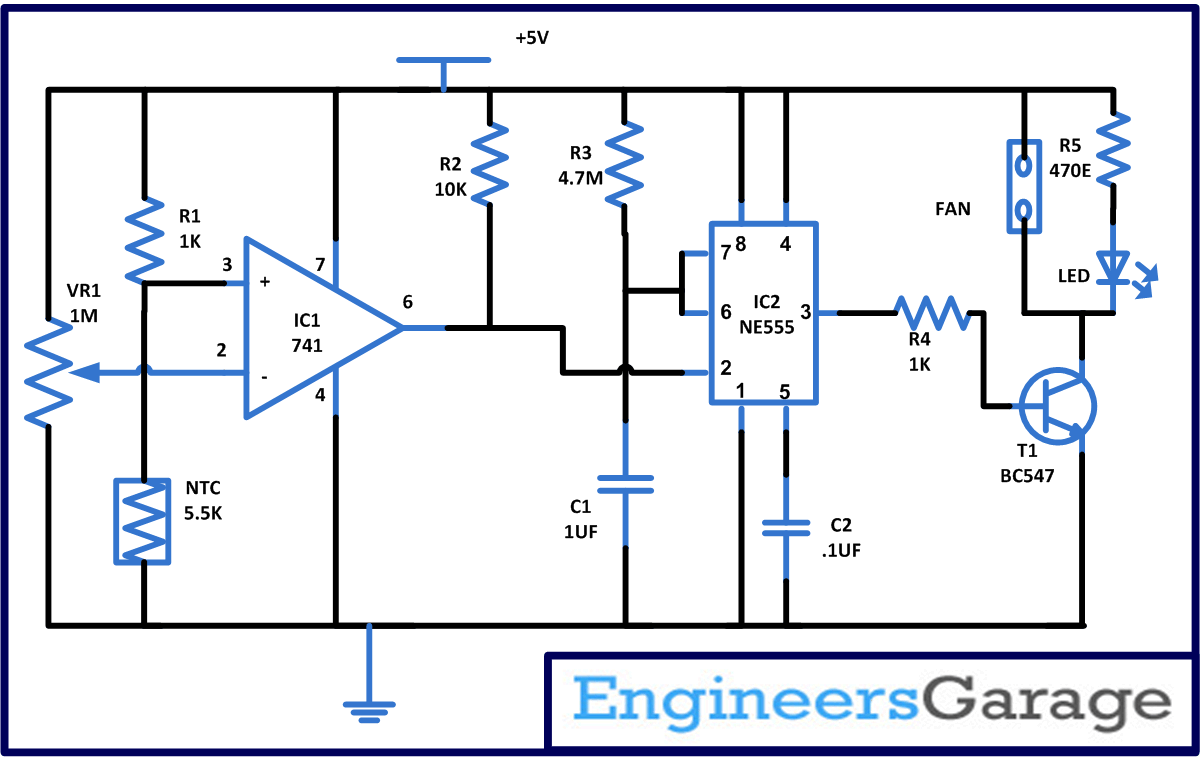Many of us have modular kitchens that have a chimney to extract the smoke, so that the smell of smoke does not fill the kitchen and avoid the harmful effects of smoke on furniture and kitchen appliances. But sometimes it happens that we forget to turn on the chimney which results in smoke in the kitchen and sometimes we forget to turn off the chimney leading to wastage of electricity and money. So, to solve this problem, we have described a circuit that will turn on the fan automatically when the smoke reaches the point and turn off the fan automatically.
You can also use this circuit during welding because as we know welding fumes are not good for health, so it will go to the fan to extract the smoke present in the room leaving a smoke free area.
((wysiwyg_imageupload:11148:))
Fig. 1: Exhaust fan circuit prototype on breadboard
This simple exhaust fan circuit is based on two ICs namely 741 which works as a comparator here and timer IC NE555 which is connected in mono-stable mode and we are using negative temperature coefficient (NTC) as a sensor with some more common and readily available components.
 Basically, the thermistor is a special type of resistor whose resistance varies with temperature. There are two types of thermistors, one is NTC and another is PTC. Thermistors are made with the help of semiconductor material and work based on the electron-hole pair theory. As the temperature of semiconductors increases, the generation of electron-hole pairs also increases and this increase in electron-hole pair decreases resistance and current flow increases. Therefore, if the resistance increases with increasing temperature, it is called PTC. And if the resistance decreases with increasing temperature it is called NTC. In the circuit described below we are using 5.5K NTC.
Basically, the thermistor is a special type of resistor whose resistance varies with temperature. There are two types of thermistors, one is NTC and another is PTC. Thermistors are made with the help of semiconductor material and work based on the electron-hole pair theory. As the temperature of semiconductors increases, the generation of electron-hole pairs also increases and this increase in electron-hole pair decreases resistance and current flow increases. Therefore, if the resistance increases with increasing temperature, it is called PTC. And if the resistance decreases with increasing temperature it is called NTC. In the circuit described below we are using 5.5K NTC.Exhaust fan circuit operation
First, carefully assemble the circuit into a compact unit and place the sensor near the chimney or near the soldering iron holder so that it can easily detect the temperature change due to the smoke.
Now in the circuit you can see that we have made pin 3 (non-inverting) of IC1 high with the help of potential divider built with the help of resistor R1 and NTC. And pin 2 (inverting pin) is used to set the reference voltage with the help of VR1.
Initially when you are in the circuit, pin 6 of IC1 is kept high and connected to pin 2 of IC2 which is also kept high through resistor R2. So at this moment the output of IC2 is low and transistor T1 will be cut off and the fan will remain off. Resistor R4 will prevent excessive base current from flowing into the transistor.
Now adjust the voltage on non-inverting pin 3 more than the voltage on inverting pin 2 and bring the hot iron closer to the thermistor. Because of the hot soldering iron, the resistance of the NTC thermistor will drop. And there will come a stage where the voltage at pin 3 will be less than the voltage at pin 2. This will cause output pin 6 of IC1 to go from high state to low state, which will trigger the momostable multivibrator and pin 3 of IC2 goes high to make the transistor come into conduction and the fan connected to it starts to rotate and the LED connected to the output also starts blinking.
The fan will continue to spin until the soldering iron is in place and when you remove the soldering iron it will spin for a fixed period of time. The fan's residence time depends on resistor R3 and capacitor C1.
Circuit diagrams
| Smoke extractor circuit |  |
Project Components
- 555 timer IC
- Capacitor
- LED
- Resistor
- BC547 Transistor

